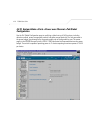
ES3000 User Guide
4-24
4.2.19 System Admin->Ports->Power over Ethernet
Use Power-over-Ethernet (PoE) to eliminate using a 110/220 VAC power source to power access
points and other devices on a wired LAN. If using a Power-over-Ethernet system, only a single CAT5
Ethernet cable carrying both power and data to each device is required. The single cable scheme
provides greater flexibility in the placement of access points and network devices and can
significantly decrease installation costs.
Two configuration pages exist for the PoE function. The first allows per port configuration for specific
power restrictions on an individual port basis. The second configuration page is used for global
configurations that apply switch-wide.
The ES3000 has a maximum PoE power budget of 170 watts. This is enough to supply 7 watts to all
24 PoE ports on the switch. The switch supplies a maximum of 16.5 watts per port.When a new
powered device is connected to a port, the ES3000 switch checks whether enough power remains in
the power budget to support the device. This decision is based on the actual power drawn by the
powered devices at the time of connection, rather than their maximum power consumption. If there
is insufficient power to supply all PoE-enabled ports, the switch does not power all ports. The
administrator can select the method the ES3000 switch uses to decide which ports receive power.
The ES3000 can sense whether a powered device is attached to a port. The switch supplies power
only to devices that need it. The switch initially uses resistance detection (802.3af) to determine
whether a port requires power. If that fails, and if capacitance detection is enabled, the switch then
uses capacitance detection to determine whether the port needs power. This allows the switch to
detect the presence of older powered devices, which might not be 802.3af compliant.


















